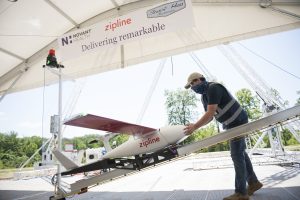Drone technology can be found in the daily operations of different industries. Lately, drone technology has been used to benefit the healthcare industry. Drones are no longer just for aerial pictures. The latest technology is becoming a lot more advanced. Amazon might be using them to deliver packages in the near future and they might also be used for healthcare services. Drones could be an important component in a hospital in the not-too-distant future.
Drones are already being used internationally to distribute blood and other critical medical supplies to sick hospitalized patients located in areas with weak infrastructure and transportation difficulties. Here are a few drone models that are revolutionizing the medical industry.
Ambulance Drones
One of the best medical drone applications comes from the Delft University of Technology in the Netherlands. A graduate student Alec Momont has developed a prototype drone which provides a defibrillator to victims in times of a heart attack. This “ambulance drone” is directed by GPS to a mobile phone destination within 4.6 square miles in less than a minute, to address the reality that the victim’s chance of survival reduces significantly with each passing minute.
Once there, the drone utilizes live streaming video and audio to provide emergency personnel with instructions on how to correctly use the defibrillator and transmit the patient’s vital signs. this kind of technology would be welcomed in the US, where heart disease is the leading cause of death for men and women claiming an estimated 600,000 lives each year.
DHL’s drone collaboration with Tanzania
In 2018, Tanzania ‘s government and DHL collaborated to launch a delivery program for medical drones, intended for the delivery and distribution of blood, life-saving medicines, and vaccines. The main objective of the government behind these initiatives was to save people’s lives by delivering medication in times of need.
Revered industry players like DJI, DHL, Embention, Matternet, Flirtey, Vayu, and Zipline are working to implement strategies to expand distribution channels in untouched locations, collaborations, and new products that have been launched to gain a higher market share.

© Novant Health 2020
Zipline medical drones
Prominent industrial player Zipline is planning to expand its medical drone delivery destination in Ghana. The healthcare drones supplied vaccines to remote areas of Africa. All of these activities encourage the use of medical drones, leading to a high level of global expansion of the market for medical drones. Market growth for medical drones is primarily associated with a growing number of drone applications in the healthcare sector.
Healthcare drones have been proven beneficial. Their growth can be seen in this sector. Drones address patients’ urgent needs regarding medicines, blood products, vaccines, and other local medical products. Such quick deliveries help healthcare professionals deliver fast treatment and save lives.
UK’s medical drone program against COVID-19
Under a COVID-19 trial program, medical delivery drones are prepped to transport supplies and equipment to a remote British isle. As part of that initiative, £8 million ($10 million) was earmarked for testing drones, and how they could be used in the years and decades ahead to deliver goods. Due to the urgent need now, healthcare officials are making use of this testing program as part of the response to COVID-19.
The program, in partnership with Solent Transport, can deploy gas-powered, fixed-wing medical delivery drones manufactured by UAV relief group Windracers and the University of Southampton.
Lab-testing delivery drones
The eight-hospital Ticino EOC organization formed a partnership with Swiss Post and US drone manufacturer Matternet to instigate faster, more efficient transport of specimens from medical laboratories.
The use of drones in this way has clear advantages. The transport time does not depend on traffic conditions or third parties, the cost is lower than by taxi and the drone can fly over hills and mountains. Additionally, when snow complicates road driving, drones would still operate and avoid delays in distributing specimens and test results.
Falck’s medical drones
The point of origin for Falck is to develop innovative solutions for the benefit of the patient, and thus development occurs in close cooperation with public partners in hospitals, universities and political councils.
Falck is essentially part of the HealthDrone project with Southern Denmark University, Odense University Hospital and Svendborg Hospital, and the Holo, Unifly and Scandinavian Avionics private partners. In Sweden, Falck is also involved in innovative drone projects.
Nicolai Søndergaard Laugesen, who is in charge of Falck’s drone project and contracts with public customers, believes that drones will be able to fly both medical staff and patients at some point, but they will not be transporting humans for now. Even crucial and essential transport in the healthcare system will become more environmentally friendly with emission-free drones since most of the transport is based on fossil fuels.
Drone technology is clearly benefitting the healthcare industry in many various ways. Ambulance drones, Zipline medical drones and Falck’s medical drones mentioned above are just some of the many drone models revolutionizing the medical industry. With the recent advancements and breakthroughs in technology, it’s almost certain that we will see more drone technology being used to restore health and offer various kinds of aid to people everywhere.
.
Asia Drone IoT Technologies lets you leverage the incredible power of drone technology for career advancements, industry applications, and learning. Find out more about:
Solutions at asiadronetech.com
Recent engagements at our Facebook page
Training programmes at drone.edu.my








